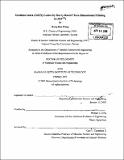| dc.contributor.advisor | Michael J. Cima. | en_US |
| dc.contributor.author | Wang, Hong-Ren, 1973- | en_US |
| dc.contributor.other | Massachusetts Institute of Technology. Dept. of Materials Science and Engineering. | en_US |
| dc.date.accessioned | 2006-03-24T18:33:42Z | |
| dc.date.available | 2006-03-24T18:33:42Z | |
| dc.date.copyright | 2005 | en_US |
| dc.date.issued | 2005 | en_US |
| dc.identifier.uri | http://hdl.handle.net/1721.1/30248 | |
| dc.description | Thesis (Ph. D.)--Massachusetts Institute of Technology, Dept. of Materials Science and Engineering, 2005. | en_US |
| dc.description | In title on t.p., superscript "TM" follows "S-3DP". | en_US |
| dc.description | Includes bibliographical references. | en_US |
| dc.description.abstract | GRIN lenses with vertical index variation and radial index variation have been successfully fabricated using S-3DPTM. Two silica-based material systems, A1203-SiO₂ and BaO-SiO₂, have been studied and used for the fabrication of GRIN lenses. Aluminum nitrate was dissolved in water to provide the dopant salt solution for S-3DPTM. The pre-sintering treatment at 1000 ⁰Cfor 24 hours in. vacuum (-5x10-6 torr) was used to remove the hydroxyl groups that cause bubbles during sintering. The sintering condition for the A1203-SiO₂ material system was found to be 1650 ⁰C for 30 minutes in vacuum. Two alumina-doped silica GRIN lenses with vertical index variation, Design 1.63 [percent] max and Design 2.5 [percent] max, were fabricated with effective focal lengths of 10.00 cm and 6.10 cm, respectively. An alumina-doped silica GRIN lens with radial parabolic index variation also was fabricated with effective focal lengths of 63.75 cm in the x direction and 52.50 cm in the y direction. The BaO-SiO₂ material system, which has a 2.4 stronger index changing ability than the A1203-SiO₂ material system, also was developed. Barium acetate was used as the dopant source. The pre-sintering treatment was found to be 900 ⁰C for 18 hours in air to convert barium acetate to barium oxide. The sintering condition was found to be 1725 ⁰C for 10 minutes in vacuum. A barium oxide-doped GRIN lens with radial parabolic index variation was fabricated. Its effective focal length was measured to be 14.63 cm in the x direction and 11.14 cm in the y direction. The barium oxide concentration profiles were measured. The theoretical focal lengths were calculated and compared with the effective focal lengths. | en_US |
| dc.description.statementofresponsibility | by Hong-Ren Wang. | en_US |
| dc.format.extent | 127 p. | en_US |
| dc.format.extent | 5330622 bytes | |
| dc.format.extent | 5346734 bytes | |
| dc.format.mimetype | application/pdf | |
| dc.format.mimetype | application/pdf | |
| dc.language.iso | eng | en_US |
| dc.publisher | Massachusetts Institute of Technology | en_US |
| dc.rights | M.I.T. theses are protected by copyright. They may be viewed from this source for any purpose, but reproduction or distribution in any format is prohibited without written permission. See provided URL for inquiries about permission. | en_US |
| dc.rights.uri | http://dspace.mit.edu/handle/1721.1/7582 | |
| dc.subject | Materials Science and Engineering. | en_US |
| dc.title | Gradient-Index (GRIN) lenses by Slurry-based Three-Dimensional Printing (S-3DP) | en_US |
| dc.title.alternative | GRIN lenses S-3DP | en_US |
| dc.type | Thesis | en_US |
| dc.description.degree | Ph.D. | en_US |
| dc.contributor.department | Massachusetts Institute of Technology. Department of Materials Science and Engineering | |
| dc.identifier.oclc | 60822242 | en_US |
